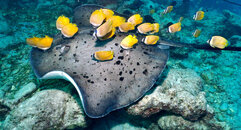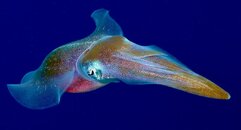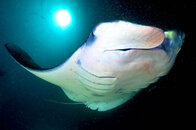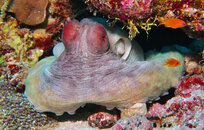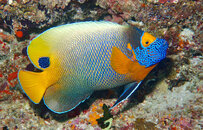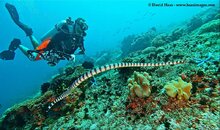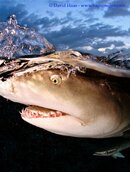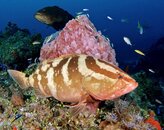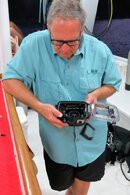edwinov
Registered
Hi,
First post here and it's immediately an urgent one as it's evening here and tomorrow morning I will start a liveaboard and having an answer by then is kind of crucial.
I do a lot of photography on land, have done a lot of filming under water with my GoPro which, with a red filter, has led to some nice results. This year I wanted to take photos under water so I boiught myself an Inon S-220 and Meikon underwater housing for my Canon G7X II.
I've been trying to figure out how this combo works in the previous days which I considered practice days for the liveaboard. I have managed to take some really nice shots with the strobe set to S-TTL and the camera to Av. All the shots that were ok or even great were close up shots, almost macro, maybe 10 cm between camera and subject. The strobe was in these cases positioned to the top left of the subject, pointing at the subject.
Photos of something further away, say a diver at 2 m distance were all dull. I had the strobe pointed forward, a little pointed outside, like they advise in all the YT videos, and further away from the camera housing. It doesn't look to me like the flash is actually doing anything in these cases. I see it flashes but the light doesn't reach the subject. How to fix this? I thought I'd just turn the dial on the flash to A+ and beyond to increase the light output, I didn't notice a difference. Is a strobe like this meant to be able to light up a subject at say 2 m distance at all?
How does S-TTL really work? How on earth would the flash know when enough light has hit the subject? Shouldn't that exclusively be the camera that knows this?
In order to save battery on the camera itself, I dialed the flash (internal flash on camera) all the way down to -2 (or whatever is the lowest), assuming the only thing the S-220 needs to see is a flash and even a fainter flash at -2 is still enough to trigger the S-2220. But does the S-220's output vary WITH the intensity of the flash from the camera it sees? I can't find any info on that. So will the Inon's flash be more intense if the camera's flash is set to +2 instead of -2? I seem to be getting better results with the flash NOT dialed back but am not sure as still so new to this. I would think the S-220 just needs some flash to trigger it and the intensity of that trigger flash is irrelevant, indeed saving me battery power (and recycle time) if I can dial it all the way back. Right?
Any other tips?
Thanks in advance,
edwinov
First post here and it's immediately an urgent one as it's evening here and tomorrow morning I will start a liveaboard and having an answer by then is kind of crucial.
I do a lot of photography on land, have done a lot of filming under water with my GoPro which, with a red filter, has led to some nice results. This year I wanted to take photos under water so I boiught myself an Inon S-220 and Meikon underwater housing for my Canon G7X II.
I've been trying to figure out how this combo works in the previous days which I considered practice days for the liveaboard. I have managed to take some really nice shots with the strobe set to S-TTL and the camera to Av. All the shots that were ok or even great were close up shots, almost macro, maybe 10 cm between camera and subject. The strobe was in these cases positioned to the top left of the subject, pointing at the subject.
Photos of something further away, say a diver at 2 m distance were all dull. I had the strobe pointed forward, a little pointed outside, like they advise in all the YT videos, and further away from the camera housing. It doesn't look to me like the flash is actually doing anything in these cases. I see it flashes but the light doesn't reach the subject. How to fix this? I thought I'd just turn the dial on the flash to A+ and beyond to increase the light output, I didn't notice a difference. Is a strobe like this meant to be able to light up a subject at say 2 m distance at all?
How does S-TTL really work? How on earth would the flash know when enough light has hit the subject? Shouldn't that exclusively be the camera that knows this?
In order to save battery on the camera itself, I dialed the flash (internal flash on camera) all the way down to -2 (or whatever is the lowest), assuming the only thing the S-220 needs to see is a flash and even a fainter flash at -2 is still enough to trigger the S-2220. But does the S-220's output vary WITH the intensity of the flash from the camera it sees? I can't find any info on that. So will the Inon's flash be more intense if the camera's flash is set to +2 instead of -2? I seem to be getting better results with the flash NOT dialed back but am not sure as still so new to this. I would think the S-220 just needs some flash to trigger it and the intensity of that trigger flash is irrelevant, indeed saving me battery power (and recycle time) if I can dial it all the way back. Right?
Any other tips?
Thanks in advance,
edwinov




